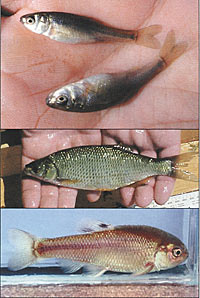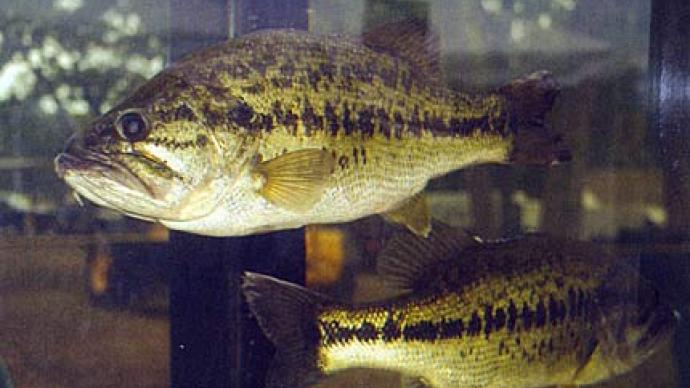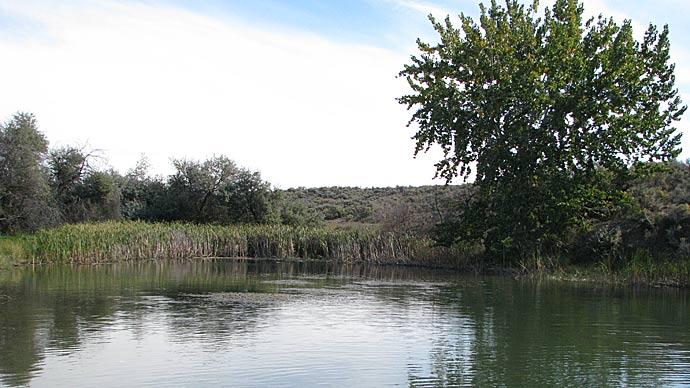
Every year I get plenty of calls from brand new pond owners asking similar questions. You may have asked the same question. "I just built a new pond, what should I stock for baitfish?" Answers depend on how and for what you want to manage your pond. Just about every one of these proud new pond owners ultimately want bass. And, more likely than not, most folks are in a hurry to get bass started.
Here is the first advice I give them ... Be patient!
In northern ponds the best bet for bass forage is to stock a cocktail of fathead minnows, golden shiners, crayfish and in some circumstances, bluegill.
Wait at least a full year before stocking any bass, largemouth or smallmouth. For the first year consider your bass pond a bait pond. Manage it for baitfish. This might mean fertilizing to promote a plankton bloom to assist survival and growth of thousands of young fish. It might mean supplemental feeding to speed the growth process a bit. Baitfish production in the first years can spell success of a northern bass pond. Lack of baitfish spells small, stunted, slow growing bass.
In the spring of the year after new pond construction is complete and there is plenty of water, stock with fathead minnows, golden shiners and local species of crayfish which like muddy pond bottoms.
Fatheads are prolific, often spawning multiple times during warmer months. Spawning begins about 60- 65F and ends at 80F. Females deposit eggs on undersides of firm objects such as flat rocks, wood, lilies, tires, pallets and similar substrate. You need firm, solid substrate in shallow water. Having solid spawning habitat is essential to breeding success. Some enterprising pondmeisters make removable structures by tossing in wooden freight pallets with ropes attached. When spawning activity stops, remove the pallets and store for next year. Don't remove structure too early though, there may be eggs attached.
Males build nests and help attach sticky fertile eggs to the clean, round spot of choice. A fathead minnow nest is about as big as a silver dollar and tiny egg masses have a grayish color tint. The male guards the nest until hatching, and then scrapes the nest clean for the next batch.
Fatheads cultured in an extensive (no feeding) situation can produce hundreds of pounds of minnows in a year, starting with just 5 pounds per acre in the spring. When stocking broodfish fatheads, the tendency is to stock the largest breeders you can find. This may not be the best strategy since males are usually larger than females and best results are achieved when you stock four or five females to every male. Buying fatheads 'pond run' makes the most sense. In breeding season, males have a dark head and spikes, called tubercles, on their heads. These bumps are used to make and guard the nest. Since males spend their entire time making and guarding nests, mortality of the biggest, oldest, male brood fish is high after spawning; consequently the recommendation to stock younger, smaller fish along with large ones, for replacement. 'Pond run' stocking helps keep the reproductive effort at full throttle throughout late spring and all summer. Fathead minnows reach maturity before age one and rarely live more than 18 months. Fatheads are a nice choice because they eat a wide range of foods including algae, insect larvae, zooplankton and dead organic material (detritus). The latter is important because fatheads continue to forage when one or more food items is gone. Detritus is available for food in nearly all pond circumstances, even new ponds. Fatheads commonly forage in near-shore shallow water. They can be purchased from bait wholesalers dirt cheap. I have recently seen them sold in the North in the range of $2.50-$10 per pound. Fathead minnows won't break the bank.
Hold the bass. Still, be patient.
In most northern ponds or small lakes the next thing to consider stocking is golden shiners. Golden shiners are intermittent spawners, which mean they can spawn throughout the northern summer from May to August when water temperatures climb above 68F. In the South this season may be extended from March to October. But, when water temperatures rise much above 80 degrees, spawning stops. Golden shiners broadcast their eggs over vegetation or filamentous algae. If your new pond lacks submerged vegetation or filamentous algae, use mats of straw or hay and place in shallow areas peripherally (Forney, 1958). In the North, shiners mature at age two, but in the South time to maturity has reportedly been as short as 7-8 months. Ponds stocked with 20 or so pounds of brood shiners can produce 100-200 pounds or more of baby shiners in a year. Shiners will forage in open waters of the pond, cropping off insect larvae, zooplankton, some filamentous algae and occasionally other fish larvae. They have been known to be predatory, limited only by their small mouth size. When stocking, buy shiners which are 2-3 years old or 4-6" in length. These are your "golden cows" and will often live to 7-9 years of age. Both golden shiners and fathead minnows should be stocked by May 1st in northern ponds, earlier in the South. Don't stock those bass yet.
Next up, stock crayfish. You can put these clawed creatures in your pond when stocking fatheads and shiners ... or stock in the fall months before. There are many species of crayfish and are hard to tell apart. Acquire crayfish stock from a reputable dealer who tells you they have come from a mud-bottom pond. In the North this usually means stocking paper shell crayfish or "grass crabs" as they are sometimes called by bait dealers. In New York and other northern areas, paper shell crayfish are probably the best species of crayfish to stock for pond culture. Paper shell crayfish are the only species of recommended by the Cornell Cooperative Extension (Forney, 1958) for pond culture. If you wait until spring to stock them make sure that the females are "berried" or have eggs under their tails. Crayfish should be stocked at 500-1000 per acre and by August of the first summer you should have thousands of 2.5" crayfish that will be future fish food. These young will stay in their burrows during the day and may not be evident milling around the pond. In the North these crayfish burrow into the mud in the late fall and winter months. Increased yield of crayfish and other shore loving bait can be increased by shoreline scalloping by increasing the amount of habitat for these critters to live and eat.
No! Not yet! Please, no bass.
But Mark! My pond is a BASS POND! No it isn't. It will be. The first three years it is focused as a BAIT POND. I would not stock a single bass until the pond has gone through one full year of bait production and for the first three years bait should dominate, not bass.
Before we get to bluegill let's talk about what is supposed to happen with the first mix of fish. In the first year of the pond, fatheads rule. They will go crazy and produce mucho pounds of bait. If the correct conditions exist (food and structure) they will dominate the pond and be visible everywhere. Meanwhile the "golden cow" shiners will be producing crops of their own and getting bigger. We want these golden shiners big. Fatheads are happily foraging along shore; shiners are foraging out in the open water. Crayfish are eating and breeding along the bottom and burrowing in when times get tough. No bass. No one is getting eaten. A northern pond baitfish Mecca.
Now, drum roll please... the bass! If you have excellent willpower you may want to let the baitfish cruise through two full growing seasons before stocking bass. Most pond owners I know can barely wait through one season. So, if you must, stock small (4-6') bass. Why so small? The small bass will hone in on those fatheads and pound the heck out of them. While the bass are growing bigger by eating fathead's near shore, your golden shiners are slipping under their radar and producing plenty of young. The original year class and as many as two additional year classes of golden shiners will get through mild bass predation because they will start out too big for small bass to eat. Several years of additional production will come from these "golden cow" shiners. While this is happening, paper shell crayfish are also flying under the radar.
But sadly, (and expectedly) the minnow banquet ends. I give this cocktail a life span of about 5-10 year's post-bass stocking. In most ponds you'll be hard pressed to find a single fathead minnow 3 years after stocking bass. A pond loaded with enough fatheads to walk across will be eaten down to none and recruitment of young shiners to spawning size will eventually be cut off by bass predation. Some paper shells will make it and may even persist despite being targeted by the bass. However, great bass growth is most often driven by them eating other fish so you will miss those minnows! But during those years the bass in your pond should have excellent growth. Eventually, the unfortunate conclusion is bass eating bass. Bass are pigs. Not happy with this scenario?
To bluegill or not to bluegill? That is the question. I know, I know. I have studied tried and true methods of stocking bass/bluegill ponds, and in the south, bluegill rules. But, that's not necessarily the case north of the Mason-Dixon line. If you stock bluegill you may want to do it at the same time you stock bass. My experiences with bluegill are mostly bad. They often overpopulate small ponds and stunt, while raising problems with bass reproduction. Bluegill often mob and rob bass nests and cause bass to have low reproductive success. See, in northern ponds bass growth very slow. A 14 inch largemouth bass may be five or six years old. So, the dynamics between bluegill and bass are very different. If you stock bluegill, you should fish the heck out of them as they mature. In small northern ponds this means removing 4-5 pounds of bluegill for every pound of bass. Few people, including me, have that kind of patience. However, they do offer increased angling opportunity, especially for kids. This should enter into your thinking. As an aside, you may design your pond with steep sides where bluegill will find the habitat inhospitable for spawning.
So then, what is a pond owner to do? Are you doomed to have a bass pond where bass are eating just bass? No and Yes, depending on your situation. No, if you have a larger body of water (like a small lake) where yellow perch or another fish can ultimately buffer some of the bass predation and the lake may have areas where forage can find refuge from bass. There are some excellent bass, perch, bluegill and golden shiner lakes that are 15-100 acres. Yes, you may be doomed to bass on bass if you have a small pond with little habitat diversity. Cheer up! I have seen some really nice bass on bass ponds, with some surprisingly large bass in them. What will slow down the progression toward an all bass pond? Maybe smallmouth bass instead of largemouth bass, but that is another story!
Reference:
Forney, J.L. 1958. Raising bait fish and crayfish in New York Ponds. Cornell Extension Bulletin 986. Cornell University, Ithaca, New York. 30pp.
Mark Cornwell is a fisheries professor at SUNY-Cobleskill in Cohleskill, New York. His passion is raising walleye and the I.Q. of fisheries students in the Northeast.
Reprinted with permission from Pond Boss Magazine



